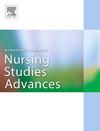Technology acceptance and use among nursing staff in Latin American hospitals: A mixed methods study
IF 3.1
Q1 NURSING
International Journal of Nursing Studies Advances
Pub Date : 2025-01-01
DOI:10.1016/j.ijnsa.2024.100290
引用次数: 0
Abstract
Background
Digital health technologies can improve health outcomes and the efficiency of healthcare delivery when used appropriately. Nevertheless, the human-computer interaction is a concern in compassionate patient care and nurses' professional well-being.
Objective
To analyze the degree of technological acceptance and use within nurses in two Latin American university hospitals.
Design
A mixed methods study design.
Setting(s)
Two Latin American university hospitals, one in Chile and the other in Colombia.
Participants
A total of 53 nurses participated in the study. In phase 1, 31 nurses took part, with 15 from a Chilean hospital and 16 from a Colombian hospital. In phase 2, 22 nurses participated, with 14 in Chile and 8 in Colombia.
Methods
: A mixed methods sequential study was conducted in inpatient services. It was developed in three phases. First, a quantitative one with a call to all nurses in two institutions, in Chile and Colombia. A scale of the unified theory of acceptance and use of technology, adapted to nursing in Spanish, was employed following expert validation both facial and content aspects. Second, a qualitative one with four focus groups with service coordinator nurses and in-depth interviews with nursing managers or supervisors. These sessions were recorded and transcribed verbatim. Quantitative data were analyzed using descriptive statistics and hypothesis testing for mean differences, while qualitative data underwent content analysis. Finally in the third phase, both qualitative and quantitative data were integrated to establish the acceptability and use of the technology.
Results
Quantitative analysis revealed a statistically significant positive correlation between behavioural intention to use the system and facilitating conditions (, ). Also, there is a positive correlation between behavioural intention to use the system and effort expectancy in Chile (, ). Additionally, a statistically significant difference () exists between the two institutions regarding social influence and facilitating conditions. Qualitative data confirmed these findings. Integration made it possible to specify the factors such as the performance expectancy, facilitating conditions, and anxiety determine the acceptability and use of technology by nurses in the studied institutions.
Conclusions
The degree of technological adoption among nursing staff in two Latin American university hospitals is currently (scale from 1 to 5). Understanding the aspects that affect the acceptance and use of technologies paves the way for achieving their best use in support of nursing care.
Registration
ING-256-2020, January 16, 2023.
Tweetable abstract
Nurses in Latin American show mixed tech acceptance. Understanding barriers is crucial for better care delivery #DigitalHealth #NurseTech
拉丁美洲医院护理人员对技术的接受和使用:一项混合方法研究。
背景:如果使用得当,数字医疗技术可以改善医疗效果,提高医疗服务效率。尽管如此,人机交互仍是病人护理和护士职业福祉的一个问题:分析拉丁美洲两所大学医院护士对技术的接受和使用程度:设计:混合方法研究设计:环境:两所拉美大学医院,一所位于智利,另一所位于哥伦比亚:共有 53 名护士参与研究。第一阶段有 31 名护士参加,其中 15 名来自智利医院,16 名来自哥伦比亚医院。第二阶段有 22 名护士参加,其中 14 名来自智利,8 名来自哥伦比亚:在住院服务部门开展了一项混合方法序列研究。研究分三个阶段进行。首先是定量研究,向智利和哥伦比亚两家医疗机构的所有护士发出呼吁。在经过专家对量表的外观和内容进行验证后,采用了适用于护理工作的西班牙语 "接受和使用技术统一理论 "量表。其次,对服务协调员护士进行了四次焦点小组讨论,并对护理经理或主管进行了深入访谈。这些访谈都进行了录音和逐字记录。定量数据采用描述性统计和均值差异假设检验进行分析,定性数据则进行内容分析。最后在第三阶段,对定性和定量数据进行整合,以确定技术的可接受性和使用情况:定量分析显示,使用该系统的行为意向与便利条件之间存在统计学意义上的显著正相关 ( r ( 31 ) = 0.50 , p .01 ).此外,在智利,使用该系统的行为意向与努力预期之间也存在正相关 ( r ( 13 ) = 0.60 , p . 05 ) 。05 ).此外,在社会影响和便利条件方面,两个机构之间存在显著差异 ( p . 05 )。定性数据证实了这些结论。通过整合,可以明确绩效预期、有利条件和焦虑等因素决定了研究机构中护士对技术的接受和使用:目前,两所拉丁美洲大学医院的护理人员对技术的采用程度为 3.7 ± 0.4(1 至 5 分)。了解影响技术接受和使用的各方面因素,有助于更好地利用技术为护理工作提供支持:Tweetable摘要:拉丁美洲的护士对技术的接受程度参差不齐。了解障碍对于更好地提供护理服务至关重要#数字医疗#护士技术。
本文章由计算机程序翻译,如有差异,请以英文原文为准。
求助全文
约1分钟内获得全文
求助全文
来源期刊

International Journal of Nursing Studies Advances
Nursing-General Nursing
CiteScore
5.80
自引率
0.00%
发文量
45
审稿时长
81 days
 求助内容:
求助内容: 应助结果提醒方式:
应助结果提醒方式:


